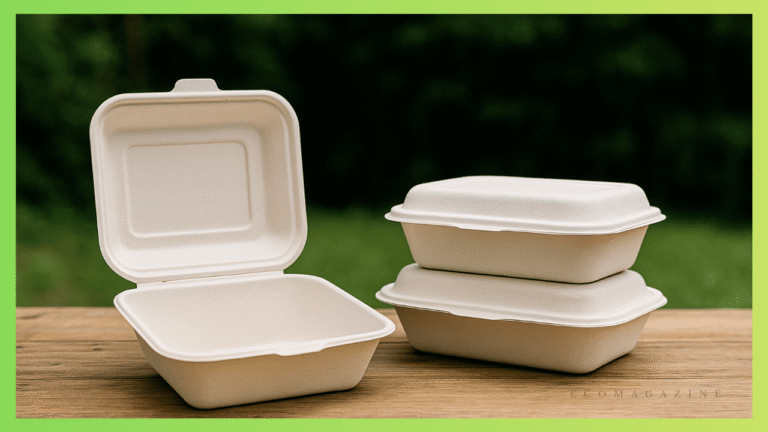Introduction
“Is your packaging as clean as your food?”
It’s a question that today’s conscious consumers are asking more than ever. As eco-awareness moves from niche to mainstream, restaurants, cafés, and food delivery services are under pressure to adopt sustainable solutions that align with both environmental goals and evolving regulations.
One of the most significant shifts in recent years has been the rapid adoption of sugarcane-based packaging, particularly sugarcane disposable containers. These fiber-based, compostable alternatives are revolutionizing the foodservice industry—offering durability, heat resistance, and environmental benefits that plastic simply can’t match.
At the forefront of this transformation stands Bioleader, a Chinese manufacturer whose innovation in bagasse packaging has made it a trusted name for sustainable tableware worldwide.
From Waste to Resource: The Science Behind Bagasse Packaging
Bagasse is the fibrous material that remains after the juice has been extracted from sugarcane. Instead of being burned or discarded—a common practice that releases greenhouse gases—bagasse is now being transformed into sustainable packaging materials.
According to the Journal of Cleaner Production (2024), using sugarcane bagasse instead of petroleum-based plastics can reduce CO₂ emissions by up to 80% per unit produced. Moreover, bagasse decomposes naturally within 60–90 days under composting conditions, returning valuable organic matter to the soil.
Unlike paper products that often require deforestation, bagasse uses agricultural waste—turning one of the world’s most abundant crops into a circular resource. It’s renewable, biodegradable, and safe for both food and the environment.
That’s why the demand for sugarcane bagasse food containers is accelerating globally, particularly among environmentally conscious foodservice operators.
Why Foodservice Businesses Are Choosing Sugarcane Packaging
Several market trends are fueling the adoption of sustainable packaging:
Plastic bans: Governments across the EU, Canada, and Asia have introduced strict single-use plastic bans and Extended Producer Responsibility (EPR) laws.
Consumer behavior: A 2025 NielsenIQ survey found that 72% of consumers prefer restaurants that use eco-friendly packaging.
Corporate ESG targets: Foodservice chains are integrating sustainability metrics into their annual reporting to attract green investors.
Bioleader’s product line meets all three demands—providing certified compostable packaging that balances environmental responsibility with operational practicality.
For instance, their sugarcane food containers are heat-resistant up to 120°C, leak-proof, PFAS-free, and sturdy enough for delivery, takeaway, and dine-in use.
The Data-Driven Edge: Performance Meets Sustainability
Scientific testing proves that bagasse isn’t just sustainable—it’s high-performing.
| Metric | Plastic (PP/PET) | Bagasse | Difference |
| Decomposition Time | 400 years | 90 days | 99.9% faster |
| CO₂ Emissions (kg/unit) | 1.0 | 0.32 | -68% |
| Energy Use | High | Moderate | -35% |
| Heat Resistance | 100°C | 120°C | +20% |
| PFAS Content | Present | None | 100% safer |
These numbers tell a compelling story. Bagasse performs as well—or better—than traditional materials while aligning with environmental and food safety standards such as EN13432, ASTM D6400, and BPI Compostable certifications.
Case Study: Bioleader’s Role in Reducing Plastic Waste
In 2024, a global meal-kit company partnered with Bioleader to replace its plastic trays and bowls with sugarcane containers.
After a six-month implementation:
Packaging waste dropped by 68% across operations.
Customer satisfaction rose by 21%, with positive feedback focusing on “eco-friendly packaging.”
Annual CO₂ emissions fell by 45 metric tons, verified through third-party environmental audits.
The company’s sustainability report cited Bioleader as a “key enabler” in achieving its 2025 green packaging milestone. This case underscores that sustainable packaging isn’t a cost—it’s a business differentiator.
Bioleader: The Manufacturer Behind the Change
Founded in Xiamen, China, Bioleader is among the few packaging companies that control every stage of production—from raw material pulping to finished goods. Its fully automated bagasse molding lines produce millions of units monthly while maintaining strict environmental and food safety standards.
Key advantages of Bioleader’s production model include:
Vertical integration: Complete in-house control ensures stable quality and faster delivery.
Certified materials: Products are EN13432, ASTM D6400, TÜV OK Compost, BPI, LFGB, and FDA approved.
R&D innovation: Development of PFAS-free coatings, hybrid bagasse-PLA packaging, and water-based barriers.
Eco efficiency: Closed-loop water recycling and solar-assisted drying systems cut energy use by 25%.
OEM/ODM customization: Tailored designs for international brands and private labels.
Bioleader’s global reach spans over 60 countries, with long-term partnerships in the EU, the U.S., and Southeast Asia. Clients describe the company as a “one-stop eco packaging supplier”—balancing sustainability, scalability, and affordability.
Why Sugarcane Packaging Is the Future
As the world transitions toward circular economies, sugarcane packaging offers a rare trifecta: renewable origin, full biodegradability, and scalable supply.
Renewable: Sugarcane regenerates annually and absorbs CO₂ during growth.
Biodegradable: Bagasse decomposes into nutrient-rich compost without leaving microplastics.
Scalable: Sugarcane is one of the world’s most cultivated crops, ensuring global material availability.
With the global packaging market expected to reach USD 1.2 trillion by 2032, sustainable materials like bagasse are no longer optional—they’re essential for compliance, branding, and long-term growth.
Industry Recognition and Environmental Impact
Bioleader’s leadership in sustainable packaging has been recognized across major industry events, including the 2025 Green Asia Innovation Awards for PFAS-free bagasse technology.
Every ton of bagasse packaging produced by Bioleader saves approximately 1.5 tons of CO₂ emissions and prevents nearly 1,000 plastic containers from entering landfills. These tangible results position Bioleader not just as a manufacturer, but as a driving force for change.
Frequently Asked Questions
1. What are sugarcane containers made of?
They’re made from bagasse, a natural byproduct of sugarcane juice extraction, which is renewable and biodegradable.
2. Are bagasse containers safe for hot food?
Yes. Bagasse containers are heat-resistant up to 120°C and safe for both microwaving and hot meal storage.
3. How long do sugarcane containers take to decompose?
Typically, 60–90 days in industrial composting facilities or a few months in home composts.
4. Why are bagasse containers better than plastic?
They reduce CO₂ emissions, avoid microplastics, and comply with international compostability standards.
5. Why choose Bioleader?
Bioleader combines innovation, certification, and global scale—offering PFAS-free, customizable, and export-ready packaging solutions.
Conclusion
The shift from plastic to plant-based packaging is more than a regulatory trend—it’s a global movement toward environmental accountability. Sugarcane containers and bagasse packaging are proving that sustainability can coexist with performance and profitability.
With companies like Bioleader leading the charge, the transition to compostable, renewable materials is accelerating. Each sugarcane container produced represents not just a meal served—but a small victory for a cleaner, more circular planet.
As the global packaging narrative evolves, one thing is clear: the future isn’t plastic. It’s powered by sugarcane.


